Heavy Luftwaffe raids on Manston and Ramsgate on 24th August 1940 leaving the airfield unserviceable

Six heavy attacks, the first at 0600 hrs (TBC) when approximately 80 aircraft crossed the coast to Thanet, left Manston unserviceable after the heavy raid at 1520 hrs, despite its many tunnels and underground shelters the RAF decided to evacuate the airfield and left for all but emergency use.
A raid on Ramsgate ‘The Murder Raid’ described at the time as “the world’s worst assault from the air”, killed 29 people, destroyed 78 houses, left 300 not fit for habitation and 700 damaged. More casualties would have been likely if not for the Ramsgate Tunnels.
Please note that we are currently in the process of compiling information for this event, so items may be added, amended or corrected in due course.
Manston
0530 hrs: No.264 Sqn Boulton Paul Defiants were sent forward from Hornchurch to Manston for air defence at 0530 hrs.

0600 hrs: The first raid (TBC).
0820 hrs: No.264 Sqn Defiant L7013 piloted by F/O Ernest William Campbell-Colquoun and P/O Gerald Robinson brought down at Manston from the attack by Bf 109s, after Verey cartridges exploded in the cockpit. Both men were unhurt. They had initially had engine trouble whilst on the ground at Manston, so had to chase after the rest of the squadron that left at 0800 hrs. Picking up a section of aircraft it appears they came upon Bf 109s instead.
0900 hrs: A large raid was built up around Cap Gris Nez, with some 100 fighters and bombers of Fliegerkorps II advanced on Dover. Two formations broke away mid-Channel and attacked Dover from the North. Eleven fighter squadrons were despatched and the raid broke up around 1100 hrs.
1028 hrs: A series of feints developed from the main raid, from which one was detached to attack Manston in a heavy attack. Manston’s defensive patrol of No.264 Squadron Boulton Paul Defiants were just landing, but the nine aircraft took off before the first bombs landed. Together with a suggested ‘Hurricane Squadron’ or possibly Spitfires of No.610 Squadron from Biggin Hill plus ground fire, the raid was turned away. Five bombers and two fighters were lost but extensive damage had been done.
1040 hrs: No.54 Sqn Spitfire I X4019 piloted by P/O Alan Roberts McLeod Campbell (42393) was damaged in combat by a Bf 109 over Manston. The pilot was injured but managed to return to RAF Hornchurch. He would not fly again until 11th September.
The Murder Raid on Ramsgate
A raid on Ramsgate ‘The Murder Raid’ was described at the time as “the world’s worst assault from the air”, killed 29 people, destroyed 78 houses, left 300 not fit for habitation and 700 damaged. More casualties would have been likely if not for the Ramsgate Tunnels, conceived by the Ramsgate Borough Engineer R.D. Brimmell, his assistants and interventions of Mayor Arthur Bloomfield Courtenay Kempe and the local MP, Captain H H Balfour. Residents in Ramsgate went into the shelters in the morning and remained there until early evening.

1138 hrs: An attack was made which resulted in severe damage to the gas works and sulphur plant. Direct hits were made on military headquarters and Customs House. Mains were fractured and houses demolished with many casualties.
More than 1,200 homes were destroyed but just 29 killed, a mixture of wardens, policemen and civilians (although reports of casualties do differ). There is a suggested list of those killed, here: http://sussexhistoryforum.co.uk/index.php?topic=2974.0
There are also some amazing photos of the aftermath, here: http://www.michaelsbookshop.com/1940/id3.htm
There is also a video here: http://www.britishpathe.com/video/ramsgate-bombed
London, Birmingham, Portsmouth and Manchester were also bombed, although it would appear that the bombing of London many have been a mistake by the Luftwaffe. Within 24 hours, RAF Bomber Command was to launch its first attack on the City of Berlin as a reprisal, starting what would be known as “The Blitz”, but allowed the RAF some critical respite to reground and recover from attacks on the airfields.
Then, as the Battle of Britain raged in the skies above, the town gained another claim to fame on August 24, 1940. It was a relatively quiet Saturday lunchtime when the air raid sirens suddenly wheezed in to life. Moments later, Ramsgate became the first place in Britain to experience the full force of the Luftwaffe’s ‘Blitzkrieg’.
In the space of five minutes, a formation of Junkers Ju88 bombers dropped more than 500 bombs in what elderly locals still call ‘the murder raid’.
Even after the bombs were dropped, fighters returned to machine gun any survivors they could find, including the firemen struggling to douse the flaming gasworks.
Fireman Edward Moore would later receive the George Medal from the King for his heroics. More than 1,200 homes were destroyed. American correspondent Hubert Knickerbocker called it ‘the worst raid in history’.
No one is entirely sure why Ramsgate was singled out. One theory is that the Germans were en route to bomb nearby RAF Manston when an armed trawler in the harbour shot down the leading aircraft and the enemy turned on Ramsgate instead.
Yet the civilian death toll amounted to just 29. The tunnels had very quickly proved their worth.”
From: http://www.dailymail.co.uk/news/article-2549058/The-secret-city-hidden-Ramsgate-Rediscovered-vast-underground-labyrinth-hospital-orchestra-saved-thousands-Hitlers-bombers.html
Manston
1240 hrs: No.264 Sqn Defiant N1535 crewed by Sqn Ldr Philip Algernon Hunter and P/O Frederick Harry King was last seen pursuing Ju88s over Manston. Both posted as missing. They are both commemorated on the Runnymede Memorial.

1245 hrs: No.264 Sqn Defiant L7027 crewed by Sgt Alan Berry (968035) and F/O Ian Garstin Shaw (40265) failed to return from combat with Messerschmitt Bf 109s off Manston. Both crew posted as missing. They are both commemorated on the Runnymede Memorial.
1245 hrs: A Junkers Ju88 A-1 of 4/KG-76 (Werk No unknown) crewed by Flugzeugführer (pilot) Leutnant Hans-Jürgen Grell 53576/5, HS Unteroffizier Alfred Wetzker 60552/77, and Bordfunker (Wireless Operator) Unteroffizier Arthur Henneberg and HB Feldwebel Martin Thomas 60552/43 were all lost at sea, Aircraft 100% write-off. Claims differ if this was shot down by a Defiant of No.264 Squadron or Hurricanes of No.501 Squadron over the Channel, south of Manston.
- Leutnant Grell’s body was washed up on 15/09/1940 and was buried the next day at Algemene begraafplaats, Haamstede, Zeeland Netherlands.
- Unteroffizier Wetzker’s and Feldwebel Thomas’ bodies were washed up some time in September 1940 and buried at Algemene begraafplaats, Haamstede, Zeeland Netherlands. Thomas was born 30 Oct 1915. Wetzker was born 31 Aug 1913.
- All three were later reburied on 01/07/1948 in Ysselsteyn, Venray Municipality, Limburg, Netherlands.
- We currently have no know resting place or record of Unteroffizier Henneberg, who apparently has no known grave.

Find a Grave


Rest in Peace Unteroffizier Arthur Henneberg wherever you may be
The No.1 ‘M’ Balloon Unit was involved in at least one of the attacks on Manston by German dive-bombers. Their ORB records the incident. Note that a ‘Nickel’ was the RAF codename for propaganda leaflets:
1250hrs: In a dive bombing raid on Manston Camp on this day, some Jerry heavy bombs scored direct hits on the hangar and storage hut causing two fires to break out at once. Balloons were scattered in all directions but were of no salvage value, many being badly burnt and others torn to shreds. All stocks of Nickels were completely destroyed together with all equipment - except one pair of scissors which were found amidst the ruins, undamaged."
No.1 'M' Balloon Unit ORB
It appears that the unit moved next day to Kidbrooke via Sheerness, then, shortly afterwards, the Unit moved a few miles up the road making a new home for itself at Grenham House School, Birchington on 19th September, where it remained for nearly two years. The School is now the site for Homebirch House, Hunting Gate/Grenham Road.
1311 hrs: No.264 Sqn Defiants were being refuelled at Manston when a force of enemy aircraft including Ju88s and Bf 109s was reported. Most of the squadron got airborne as the bombs started to hit the base but were unable to gain enough height quickly enough to prevent being pounced on by the German fighters.
The squadron lost four aircraft and seven airmen this day, destroying four enemy bombers and two Bf 109s. Total losses of 12 Defiant aircraft and 14 crew over the last three days forced Fighter Command to eventually withdraw it as a front line day fighter.
The Squadron was sent on patrol and after an inconclusive engagement, landed at Manston to refuel and rearm. We had just completed that but were not ordered up again until we were scrambled in a hurry just as a number of Ju 88s were attacking Ramsgate and the edge of the airfield. We took off in twos and threes but had no time to form up as a Squadron. I had one new crew in my Section (Plt Offs Jones and Ponting) and we chased after the bombers as they headed for France. It was a long stern chase and before we were near enough to engage them, I spotted five enemy fighters. I at once called up Jones, “Bandits! Line astern – evasive action!” and turned as hard as possible as they attacked. Unfortunately, Jones did not turn hard enough and was hit and went down immediately. All five aircraft then concentrated on me and as each came in, I turned hard giving my gunner, Sgt Martin, a straight no deflection shot. I saw strikes on one or two of them and one went down into the sea. On one occasion, Martin did not fire – I do not think I swore at him but asked him why. “You blacked me out” was his answer. We were miles out to sea and it meant I had to keep turning hard as each plane attacked and I began to think that we should never get back to the Kent coast but the attacks ceased. (I like to think that we had damaged the four other aircraft but probably they had run out of fuel or ammunition). We landed back at Hornchurch with no damage but the squadron had suffered disastrously. We had lost our Commanding Officer, Sqn Ldr Philip Hunter, who had been so good at welding together the squadron and at developing Defiant tactics, and two other crews. In the afternoon we were at readiness again at Hornchurch, sitting in our aircraft as there was so much enemy activity. We learnt there were bombers aiming in our direction but we were kept on the ground until over the Tannoy came the order “264 Squadron scramble, scramble, scramble!”. Personally I blame the panic in the voice for the serious damage to two Defiants – they collided on the ground when taxiing. As the rest of us took off, the bombs were falling on the airfield just about where we had been a moment before. A formation of Heinkels was overhead at 10,000-15,000ft. We did not have chance to catch them. I believe that one or two of our machines were attacked by fighters and we lost one, the pilot being saved but the gunner dying of wounds.
Pilot Officer Eric Barwell, 264 Squadron – from Luftwaffe Fighters and Bombers: The Battle of Britain by Chris Goss
1415 hrs: All communication between Manston and 11 Group was lost by the destruction. The controller at 11 Group contacted No.1 Observer Group at Maidstone to see if they could find out what was going on. A mile from Manston was Post A.1, and Observer Foad volunteered to cycle to the airfield and obtain information. Coastal airfields had been reduced to dire straits.
When the cable maintenance inspector at Manston was informed that all lines had gone he took two jointers and went to the particular crater despite the continuing explosion of delayed action bombs. Working like beavers, and with only an occasional glance at a large bomb adjacent to them, the three men got the essential circuits (out of 248 severed) restored in two hours and completed permanent restoration the following day.
As soon as word got through of the state of the station Fighter Command decided to evacuate it, except as an emergency airfield. Administrative personnel were transferred permanently to Westgate while the remainder of No.600 Squadron’s Blenheims were moved to Hornchurch.
Time unknown: F/L William “Bill” James Green of No.501 Sqn was scrambled from Hawkinge with his squadron to intercept a raid at Manston. Green closed in to attack an enemy dive-bomber when his aircraft was hit by the airfield’s anti-aircraft fire. His Hurricane was badly damaged and the engine stopped, but he managed to glide back to Hawkinge. There he discovered that half of the undercarriage had been shot away – he crash landed and scrambled from the wrecked aircraft.
“We were homing in on the Ju 88s from behind them when there was a bang and my aeroplane was covered in thick, black oil. The engine stopped and started again – it was coughing – and I realised I had to get back down so I turned away and went back to Hawkinge where I crash landed: I landed the plane but it tipped up on its nose.
Bill Green
“I think I must have been hit by our anti-aircraft fire. It was the first time I had ever been hit. It wasn’t a bundle of laughs, but I was fine. I was flying again the next day at dawn – in another Hurricane.”
Flight Lieutenant Bill Green died aged 97 on 7 November 2014.
Events with times currently unknown on this day
Felwebel Herbert Bischoff of the 1st Staffel Jagdgeshwader 52 force-landed his Bf 109E ‘White 9’ of JG52 on the Minster Road, at Westgate.
Bischoff was on an early afternoon sortie supporting Luftwaffe bombers over the Thames Estuary (it is unknown if this was connected with the attack on Manston at this time), operating from the French airfield of Coquelles. Bischoff was flying Messerschmitt Bf 109E ‘White 9’ when his aircraft suddenly lost power. Reports including official Luftwaffe report suggest this was not the result from being attacked, although a letter from Bischoff to Dick Hambridge in 1990, who visited the crash site and later wrote to him, suggested that he could still remember every detail of the Spitfire that had shot him down over London at 15,000 feet. Spiralling down, he desperately looked for a suitable place to land the now-silent machine and chose a recently harvested field alongside the Minster Road at Westgate-on-Sea. Holding off to ‘belly-in’, he clipped the port wing on an anti-glider concrete post and bent all three propeller blades as he ploughed his way to a stop. Although shaken, he was uninjured and taken as Prisoner of War for seven years.
P/O George D. Gribble of No.54 Squadron would make the claim.
I was leading ‘B’ Flight when the Squadron attacked about nine HE 113s (sic) over Dover and itself was attacked by a large number of Me 109s. After a dogfight in which I engaged several enemy aircraft but was unable to see any results of my fire, I joined up with three other Spitfires over Manston and proceeded to Hornchurch. Between Manston and Herne Bay, I saw about fifty ME 109s in vics line astern. I dived onto the last section and fired the remainder of my ammunition (about ten seconds’ worth) in bursts from 250 yards in astern attack. My last burst hit the starboard radiator and after that, the aircraft fell away out of control.
The crash-landing was not witnessed but the aircraft was heard and then seen by one teenager soon afterwards.
Account by P/O George D. Gribble from “Luftwaffe Fighters and Bombers: The Battle of Britain” by Chris Goss
I joined JG 52 in February 1940 and flew about sixty to seventy operational flights of which twenty-five where over England. I had just half a kill to my name – a Spitfire together with Uffz Ignatz Schinabeck between Calais and Dover on 11 August 1940. On my last flight of 24 August it was a Spitfire that got me – coming out of the sun above me. He hit my engine which was then kaput. I was at 6,000m near London at the time. I dived away but soon realised that it was impossible to get back to my airfield at Coquelles as by then even my radiators were kaput so I crash landed near Margate and became a prisoner of war for the next seven years.
Felwebel Herbert Bischoff from “Luftwaffe Fighters and Bombers: The Battle of Britain” by Chris Goss
Quickly apprehended, he left the scene with Army guards. Soon after, an RAF car arrived at the site with an officer from Air Ministry Intelligence A.I.2g to look over the relatively intact fighter; his name was Pilot Officer Horace Frederick King, and his speciality was German armament.

“It was mid-afternoon. My mother and I were sitting in our Anderson Shelter. We could hear the guns firing and the aircraft zooming around, and all of a sudden there was a terrific loud “zoom” right over the top of us. It frightened the life out of us by it was all over in a split second. A little while after our Air Raid Warden called into the garden and told us that it was a Messerschmitt that had just gone over, and it crash landed in a cornfield which was about a quarter of a mile away from where we lived.
I scrambled straight out of the shelter and told my mum “I’m going out to the crash to have a look for myself”. I hadn’t ever seen a Messerschmitt on the ground before. When I got there you could see where the Messerschmitt had struck a concrete post alongside the cornfield and had ripped off part of the left wingtip. The concrete post was bent right over and the aircraft must have spun quite a bit on impact. The cornfield was off Minster Road at Westgate-on-Sea in Kent. All the open fields around this part had either concrete or iron posts sticking out of the ground and I understand that they were part of the plan to stop German aircraft landing if ever there was an invasion, that is why they were put there.
One of my old schoolmates worked on the farm. His family cottage was about fifty yards from where the Messerschmitt finished up and he was one of the first out to the crash. He told me that when the Pilot got out of the Messerschmitt, he was shaking like a leaf, but he was O.K. and not injured at all. He was very lucky after hitting that concrete post! Now the interesting part is that after all these years, I am now writing to that Pilot in Germany, and he has told us that he would like to come over and meet us one day so that I can take him out to the site where he crashed.”
Account from Dick Hambridge who lived in 6 Wellesley Road, Westgate-on-Sea, recorded in “We remember the battle of Britain”.
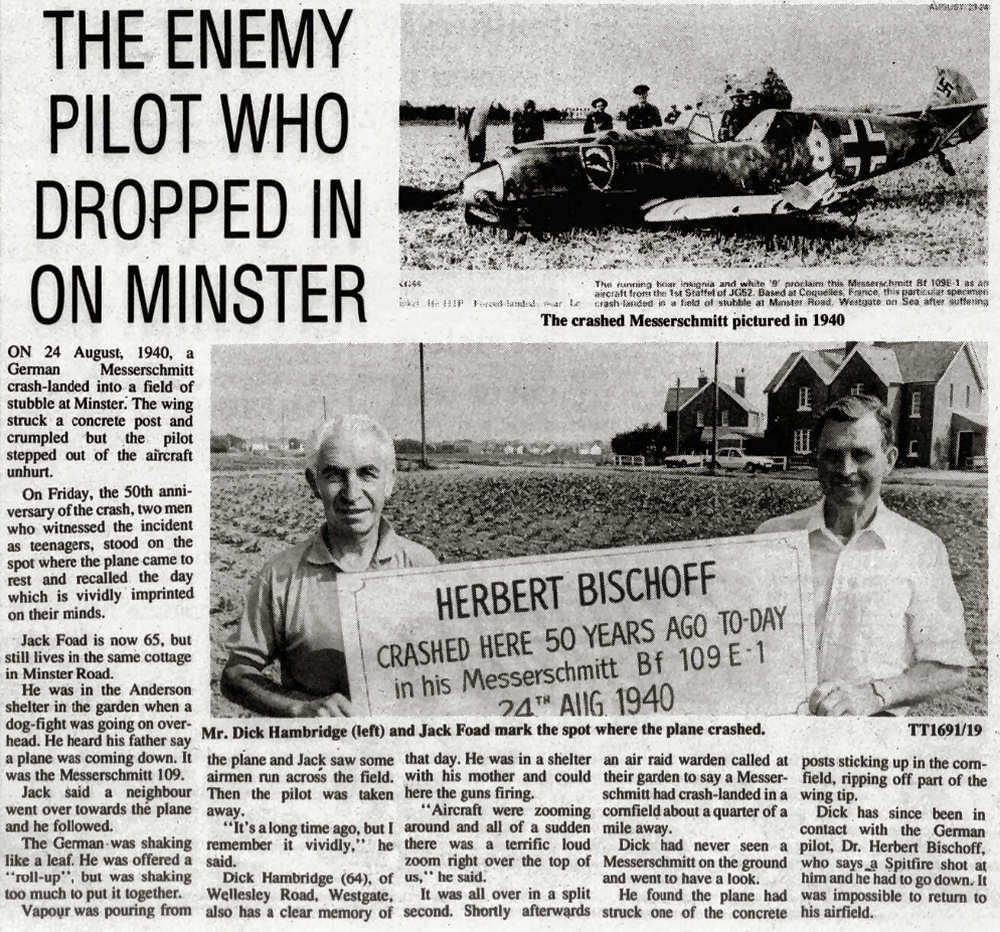
When Bischoff’s Bf 109 was taken away by lorry two days later, it apparently photographed by a local air raid warden (although the photos that often appear in connection with this are thought to actually be those of Feldwebel Heinz Uerlings who crashed landed on 2nd September 1940 two miles north-east of Sturry, Kent). The photos of either Boschoff’s or Uerlings’ aircraft resulted in the amateur photographer being brought before Margate Police Court charged with “photographing the wreckage of a German aeroplane without a permit’. The magistrate left the warden off with a warning. The photo of Uerlings’ aircraft features a couple of New Zealand soldiers giving the photographer the thumbs-up as they passed, but it is clear on close inspection that the damage is different.
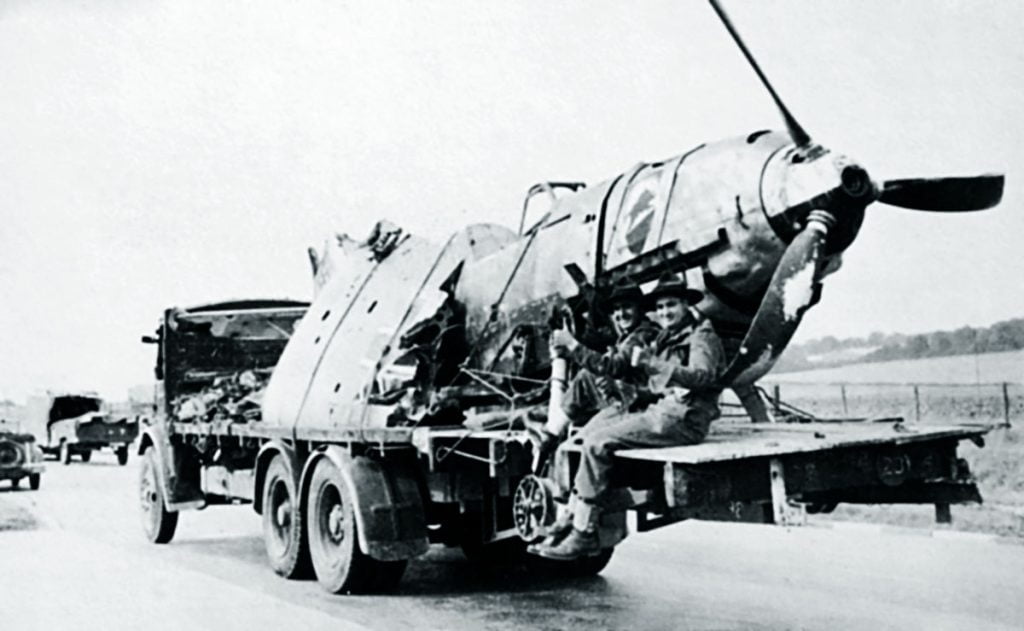

II./KG 76 lost five aircraft on 24th August 1940 according to the Gen Qua Luf 26 Aug 1940.
Stabsstaffel II./KG76 Junkers Ju88A-1 (Werk No unknown) was shot down (believed by AA fire) during combat with RAF fighters over the Channel off Manston (or otherwise noted as ‘over Manston’). Major Friedrich Möricke (Gruppenkommandeur)(Observer), Oberleutnant Karl Schulte (Gruppe Ia) (Pilot), Sonderführer Erwin Bleeck-Wagner (Gunner of Lw.Kr.Ber.Komp.4 and a war correspondent) were all killed when they crashed into the English Channel off the Kent coast. Some reports suggest the Bordfunker (Radio Operator) was believed rescued unhurt, but this would appear to be Ofeldw Fritz Jacobsmeyer who was killed (washed ashore on 17.09.40 at Vlissingen, Netherlands). Aircraft 100% write-off.
- Oberleutnant Schulte’s body was washed ashore on 06.09.40 at Da Penne, Belgium. He is buried in Lommel German Military Cemetery, Lommel, Arrondissement Maaseik, Limburg, Belgium, block 42, grave 535.
- Major Möricke’s body was later washed ashore on 31.08.40 at De Panne, Belgium. He is buried in Lommel German Military Cemetery, Lommel, Arrondissement Maaseik, Limburg, Belgium, block 42, grave 387.
- Lt. Bleeck-Wagner’s body was washed ashore at Vlissingen, Netherlands, where he was first buried. on 18/12/1948, he was re-buried at Deutscher Soldatenfriedhof Ysselsteyn, Ysselsteyn, Venray Municipality, Limburg, Netherlands. grave BB-4-84.
- Ofeldw Fritz Jacobsmeyer’s body was washed ashore on 17.09.40 at Vlissingen, Netherlands, where he was first buried. on 18/12/1948, he was re-buried at Deutscher Soldatenfriedhof Ysselsteyn, Ysselsteyn, Venray Municipality, Limburg, Netherlands. grave BB-4-82.
Stabsstaffel II./KG76 Junkers Ju88A-1 was shot down by Hurricanes of No.501 Squadron and crashed in the Channel off Manston 12.45 p.m. Felwebel Fritz Vetter (Pilot), Felwebel Karl Flessner (Observer), and HS Uffz Heinrich Meier all missing, Felwebel Hans Meyer 60551/13 (Radio Operator) killed. Aircraft 100% write-off. Hans Meyer was later washed ashore on the Dutch coast.
4./KG76 Junkers Ju88A-1 returned to base severely damaged by Hurricanes of No.501 Squadron following attack on Manston 12.45 p.m. Oberfw Fritz Jakobsmeier (Radio Operator) killed, rest of crew believed unhurt. Aircraft 100% write-off.
4./KG76 Junkers Ju88A-1 was shot down in the Channel by Hurricanes of No.501 Squadron following attack on Manston 12.45 p.m. Unteroffizier Erich Dubs (Observer), Unteroffizier Horst Freimann (Radio Operator), and HS Unteroffizier Hans Fröba missing. Unteroffizier Jakob Krüll 60554/30 (Pilot) killed. Aircraft 100% write-off.
Jakob Krüll was later washed ashore on the Dutch coast.

1530 hrs (just after): The remaining Defiants of No.264 Sqn were forced to scramble from Hornchurch when the airfield came under attack, after returning there earlier. Two Defiants collided as they raced to take off.
1530 hrs: Another big raid stacked up over Le Havre and flew to Manston and Ramsgate.
1539 hrs: Manston was attacked again. Living quarters were badly damaged and hardly any buildings remained intact. All telephone and teleprinter lines were cut and the airfield was littered with unexploded bombs.
1600 hrs: No.264 Sqn Defiant L6965 piloted by P/O Richard Stuart Gaskell was badly damaged near Hornchurch by Bf 109s of JG51. Pilot safe, but air gunner Sgt William Howard Machin died of his wounds and is buried in Handsworth Cemetery, Sec. 22. C. of E. Class B. Grave 12885. Aircraft written off.
During the day, Aircraftman 2nd Class Alexander Kirk (1103925) RAFVR aged 25, Leading Aircraftman Henry Allan Shackleton (343404) RAF aged 38, Aircraftman 2nd Class William Fairfield (1358170) RAF aged 48, Aircraftman 2nd Class Frank Walker (1007477) RAFVR, Aircraftman 1st Class Harry Lewis Burridge (646963) RAF aged 20, were killed and multiple personnel injured.
- Aircraftman Kirk and Fairfield are buried at Minster Cemetery.
- Aircraftman Shackleton is buried in Chatham (Palmerston Road) Cemetery.
- Aircraftman Walker is buried in Tottington (St. John) Free Church of England Chapelyard.
- Aircraftman Burridge is buried in Saint John’s Cemetery, Worcester.
Ramsgate Airport
An attack was made on Ramsgate Airport by part of the 1530 hrs raid, damaged airport buildings and houses. ARP personnel were machine-gunned by two low flying aircraft, casualties not reported.
Further Information
http://ramsgatetunnels.org/history.html
http://www.michaelsbookshop.com/1940/id3.htm
First published: 24th August 2018.
Last Updated: .


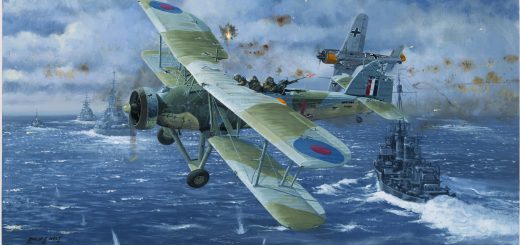










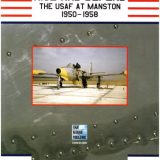




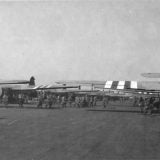
Very informative commemorative site to many brave RAF men pilots & gunners of the RAF
Well done & thank you